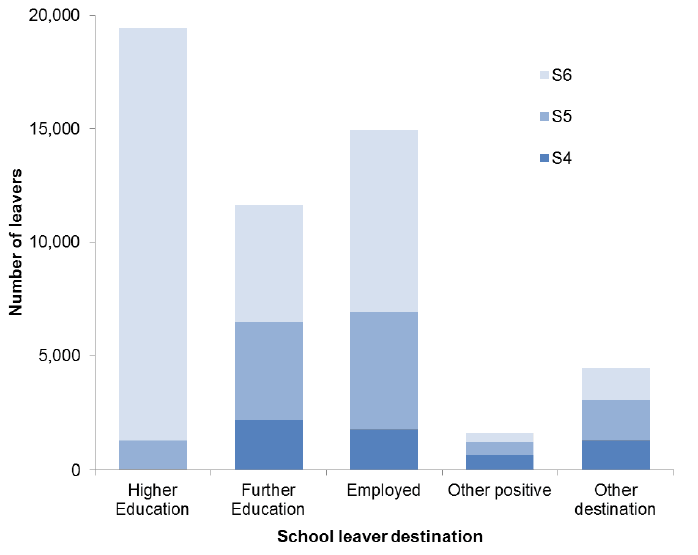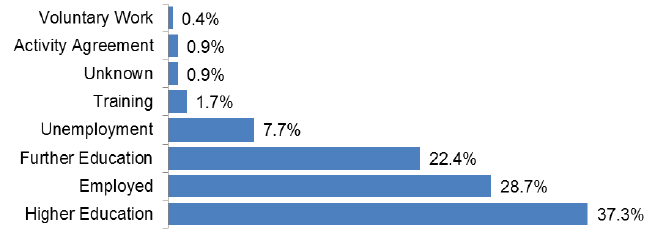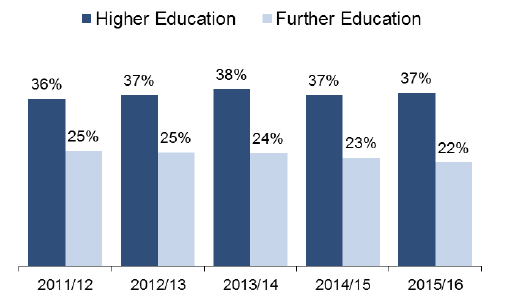Attainment, school leaver destinations and healthy living: education statistics summary
Results of the initial and follow-up surveys of leaver destination (S3-S6), post-appeal attainment, school meals and physical education provision.
Chapter 2: Leaver destinations
- 91.4 per cent of 2015/16 leavers in a positive follow-up destination in March 2017 (92.0 per cent for 2014/15).
- The majority of leavers went onto higher education (37.3 per cent).
- Almost two thirds of 2015/16 leavers left at the end of S6.
2.1 Skills Development Scotland leaver destinations data
Information on the destinations of school leavers is provided from the Opportunities for All shared dataset managed by Skills Development Scotland ( SDS). This information is used to inform 16+ Learning Choices , and other policy initiatives, and helps ensure that adequate support is provided for young people who may require help with entering and sustaining a positive destination.
Destination data from SDS is matched to the Scottish Government's ( SG) pupil census in order to identify the cohort of senior phase school leavers from local authority or grant aided secondary schools. A pupil is counted as a school leaver if they have a leaver record in SDS's data, a pupil census record for the same academic year, and no pupil census record in the following academic year. Information is collected on the destination of school leavers in the October after they leave school (initial destination) and again the following March (follow-up destination).
For the purposes of this publication school leavers who are engaged in higher education, further education, training, voluntary work, employment or activity agreements are classified as having a 'positive destination'. Other destinations include school leavers who are unemployed and individuals where their initial destination is not known. For full definitions of leaver destinations please see background note 7.3.2.
A new publication reporting on the initial destinations of senior phase school leavers was published by the Scottish Government for the first time in March this year. The 'Initial Destinations of Senior Phase School Leavers' publication ( http://www.gov.scot/Topics/Statistics/Browse/School-Education/SeniorLeavers) followed the cessation of the SDS publication 'Initial School Leaver Destinations' which was published for the final time in December 2015 (see http://www.skillsdevelopmentscotland.co.uk/publications-statistics/statistics/archived-school-leaver-destinations). The leaver cohort for that publication focused exclusively on school leavers from the senior phase (S4-S6) whereas the leaver cohort for this publication comprises all school leavers ( i.e. including S3 leavers).
2.2 Matched school leaver destinations
The school leaver destinations data is matched to the pupil census so that pupil characteristics and attainment data can be linked to the destinations. If a robust match can be made, more valuable conclusions can be drawn from the data. Only leavers with a match to the pupil census are included in the analysis within this publication. This means that some leavers are excluded from the analysis (see background note 7.3.1 for more information on the matching process and the changes from previously published data). The timing of the school leaver cohort was changed for the 2014/15 leaver cohort and remains the same for the 2015/16 cohort. The 2013/14 cohort data were revised to accommodate this change but data for previous years are based on the original timing. See background note 7.2.2 for information on changes to the timing of the school leaver cohort.
For 2015/16 school leavers, almost two thirds (64 per cent) left at the end of S6, a quarter (25 per cent) left at the end of S5, and 11 per cent left at the end of S4. Around 0.1 per cent left in S3 or another stage. Table 1 and Chart 1 show leavers by stage for 2015/16 school leavers.
Table 1: Number and percentage of leavers by stage of leaving, 2015/16
| Stage of leaving | S6 | S5 | S4 | S3 | Other |
|---|---|---|---|---|---|
| Number | 33,294 | 13,169 | 5,786 | <50 | <20 |
| Percentage | 63.7% | 25.2% | 11.1% | <0.1% | <0.1% |
For 2000/01 to 2008/09 school leavers, the percentage of S4 pupils staying on at school until S6 remained largely unchanged at around 45 per cent. However, since 2009/10 the staying on rate has been increasing, reaching 63 per cent in 2016/17 (source: Pupil Census data). Therefore the profile of leavers will have changed notably over this time period.
Looking at the follow-up destinations of 2015/16 school leavers by stage of leaving, it is clear that the majority of leavers who enter Higher Education have remained at school until S6. Chart 1 also shows:
- for S5 leavers, the most common follow-up destination was employment (39 per cent of S5 leavers) closely followed by Further Education (33 per cent);
- for S4 leavers, the most common destination was Further Education (38 per cent of S4 leavers), although S4 leavers account for less than a fifth of all the leavers in Further Education;
- due to the small numbers of leavers from S3 or other stages it is difficult to represent this on the chart; of the leavers from S3 or other stages, 71 per cent were in a positive follow-up destination.
Chart 1. Follow-up destination of leavers by stage of leaving, 2015/16

1. Other positive includes activity agreements, training and voluntary work.
2. Other destination includes unemployed seeking, unemployed not seeking, and unknown.
Table 2 shows that the percentage of all 2015/16 school leavers in a positive follow-up destination was 91.4 per cent, this was lower than the proportion in 2014/15 (92.0 per cent) and lower than the percentage of 2015/16 school leavers in a positive initial destination (93.3 per cent).
Charts 2 and 3 show that in March 2017, 59.7 per cent of the 2015/16 leavers were in Higher or Further Education, similar to previous years but slightly lower than in 2013/14 (62.5 per cent). The proportion in employment has increased to 28.7 per cent from 27.8 per cent for 2014/15 leavers, while the percentage unemployed has slightly increased from 7.3 per cent for 2014/15 to 7.7 per cent for 2015/16 leavers.
Table 2. Percentage of school leavers by initial and follow-up destination category, 2011/12 to 2015/16
Column Percent (percentages may not total 100 due to rounding)
| Percentage | ||||||||||
|---|---|---|---|---|---|---|---|---|---|---|
| 2011/12 | 2012/13 | 2013/14 | 2014/15 | 2015/16 | ||||||
| Destination Category | Initial | Follow-up | Initial | Follow-up | Initial | Follow-up | Initial | Follow-up | Initial | Follow-up |
| Higher Education | 37.8 | 36.1 | 37.1 | 36.9 | 39.0 | 38.2 | 38.8 | 36.8 | 40.3 | 37.3 |
| Further Education | 26.6 | 24.8 | 27.7 | 24.5 | 26.3 | 24.3 | 27.6 | 23.4 | 26.6 | 22.4 |
| Training | 4.5 | 3.6 | 4.8 | 3.1 | 4.0 | 2.5 | 3.8 | 2.7 | 2.6 | 1.7 |
| Employment | 19.8 | 23.9 | 20.4 | 24.6 | 21.7 | 25.5 | 21.4 | 27.8 | 22.3 | 28.7 |
| Voluntary Work | 0.4 | 0.5 | 0.5 | 0.5 | 0.4 | 0.4 | 0.4 | 0.5 | 0.5 | 0.4 |
| Activity Agreement 1 | 0.9 | 0.7 | 1.3 | 0.9 | 1.0 | 0.7 | 0.9 | 0.7 | 1.0 | 0.9 |
| Unemployed seeking | 8.1 | 8.1 | 6.9 | 7.6 | 6.2 | 6.5 | 5.4 | 5.7 | 5.1 | 5.8 |
| Unemployed Not Seeking | 1.3 | 1.8 | 1.1 | 1.6 | 1.1 | 1.5 | 1.1 | 1.6 | 1.3 | 1.9 |
| Unknown | 0.4 | 0.6 | 0.3 | 0.3 | 0.3 | 0.3 | 0.5 | 0.6 | 0.2 | 0.9 |
| Positive Destinations | 90.1 | 89.6 | 91.7 | 90.4 | 92.5 | 91.7 | 93.0 | 92.0 | 93.3 | 91.4 |
| Number of Leavers | 49,745 | 49,610 | 51,647 | 51,515 | 51,416 | 51,293 | 52,491 | 52,337 | 52,305 | 52,113 |
1. In April 2011 the Scottish Government rolled out the use of Activity Agreements.
Chart 2. Follow-up destinations 2015/16

Chart 3. Percentage of leavers in HE & FE in follow-up

2.3 School leaver destinations by pupil characteristics
Table 3 shows the positive follow-up leaver destinations for pupils by various characteristics taken from the pupil census. The percentage of leavers in positive follow-up destinations has decreased for most groups compared to 2014/15. The table shows the extent to which pupils from areas of high deprivation continue to be less likely to enter positive destinations. Although the percentage has declined since 2014/15, they are improving at a faster rate than less deprived pupils. Pupils with additional support needs ( ASN) are similarly less likely to be in a positive destination.
The ethnic group which has the highest percentage of leavers in a positive follow-up destination is Asian - Indian (96.9 per cent); in previous years Asian - Chinese had the highest proportion of leavers in a positive follow up destination. Although rates for all other groups have declined, the proportion of Asian - Indian leavers going onto a positive destination has improved.
Girls also continue to be more likely to enter a positive destination than boys; 92 percent of girls and 91 per cent of boys enter a positive destination. Splitting leavers by urban rural classification, leavers from remote rural areas have seen the largest decrease from 95.6 per cent in 2014/15 to 93.0 per cent in 2015/16. Leavers from large urban areas continue to have the lowest proportion in positive destinations (90.0 per cent) and the rate for accessible small towns remains the same as 2014/15 (93.4 per cent). More information on destinations by pupil characteristics is available in the supplementary tables. A list of the tables is available at background note 7.5.
Table 3. Percentage of school leavers in a positive follow-up destination, by pupil characteristic, 2011/12 to 2015/16
| Percentage | |||||
|---|---|---|---|---|---|
| 2011/12 | 2012/13 | 2013/14 | 2014/15 | 2015/16 | |
| Gender | |||||
| Male | 88.5 | 89.3 | 90.6 | 91.3 | 90.6 |
| Female | 90.7 | 91.6 | 92.8 | 92.8 | 92.2 |
| Ethnicity 1 | |||||
| White - Scottish | 89.5 | 90.3 | 91.5 | 91.9 | 91.3 |
| White - non-Scottish | 89.9 | 92.1 | 92.8 | 92.1 | 92.5 |
| Mixed or multiple ethnic groups | 86.4 | 92.0 | 93.6 | 92.8 | 92.7 |
| Asian - Indian | 93.9 | 91.2 | 96.6 | 96.3 | 96.9 |
| Asian - Pakistani | 92.7 | 92.4 | 93.2 | 95.2 | 92.5 |
| Asian - Chinese | 98.3 | 98.8 | 98.8 | 97.1 | 95.9 |
| Asian - Other | 94.4 | 95.7 | 97.0 | 96.2 | 95.1 |
| African/ Black/ Caribbean 2 | 94.8 | 91.9 | 96.0 | 94.4 | 92.3 |
| All other categories 3 | 91.9 | 92.1 | 91.9 | 91.2 | 87.9 |
| Not Disclosed/Not known | 87.0 | 88.1 | 88.5 | 90.1 | 88.8 |
| Urban/Rural | |||||
| Large Urban Areas | 88.1 | 89.0 | 90.6 | 91.5 | 90.0 |
| Other Urban Areas | 89.9 | 90.4 | 91.4 | 91.6 | 91.4 |
| Accessible Small Towns | 90.2 | 92.1 | 93.1 | 93.4 | 93.4 |
| Remote Small Towns | 91.1 | 93.1 | 93.1 | 93.2 | 92.8 |
| Accessible Rural | 90.1 | 90.4 | 92.5 | 92.6 | 92.3 |
| Remote Rural | 93.5 | 94.2 | 95.5 | 95.6 | 93.0 |
| SIMD 4 | |||||
| 0-20% (Most Deprived) | 81.9 | 83.0 | 85.0 | 86.3 | 85.0 |
| 20-40% | 86.8 | 87.8 | 89.4 | 89.7 | 89.7 |
| 40-60% | 90.2 | 91.7 | 92.4 | 92.9 | 92.3 |
| 60-80% | 93.3 | 93.7 | 94.7 | 95.1 | 94.2 |
| 80-100% (Least Deprived) | 95.3 | 95.9 | 96.8 | 96.3 | 96.2 |
| Additional Support Needs 5 | |||||
| ASN | 82.0 | 82.5 | 84.3 | 85.7 | 84.7 |
| No ASN | 90.7 | 92.0 | 93.3 | 93.6 | 93.4 |
| All Leavers | 89.6 | 90.4 | 91.7 | 92.0 | 91.4 |
1. The categories used to collect ethnicity and national identity data changed in the 2011 pupil census to agree with the categories used in the main population census. This means they are not directly comparable with information collected in previous years and 'White - UK' and 'White - Other' could not be calculated for more recent years so are represented by N/A, and 'White-Scottish' and 'White-non-Scottish' could not be calculated for 2009/10 and 2010/11. Some categories have been grouped together due to small numbers. Some categories contain between 100-200 leavers.
2. For 2011/12, 2012/13, 2013/14, 2014/15 and 2015/16 the 'African/ Black/Caribbean' category includes 'African', 'African - Other', and the 'Caribbean or Black' categories.
3. For 2009/10 to 2010/11 'All other categories' includes 'Occupational, Gypsy and Other travellers' as well as the 'Other' category. For 2011/12, 2012/13, 2013/14, 2014/15 and 2015/16, 'All other categories' includes 'Other - other' and 'Other - Arab'.
4. Based on SIMD 2009 for 2009/10 and 2010/11, and SIMD 2012 for 2011/12, 2012/13, 2013/14, 2014/15 and 2015/16. 2011/12 has been revised as all leavers are now matched by SIMD. More information on the Scottish Index of Multiple Deprivation can be found at: http://www.gov.scot/Topics/Statistics/SIMD.
5. Pupils who have a CSP, IEP, Child's Plan are assessed or declared disabled or have another need.
Contact
Email: Marion MacRury
Phone: 0300 244 4000 – Central Enquiry Unit
The Scottish Government
St Andrew's House
Regent Road
Edinburgh
EH1 3DG
There is a problem
Thanks for your feedback